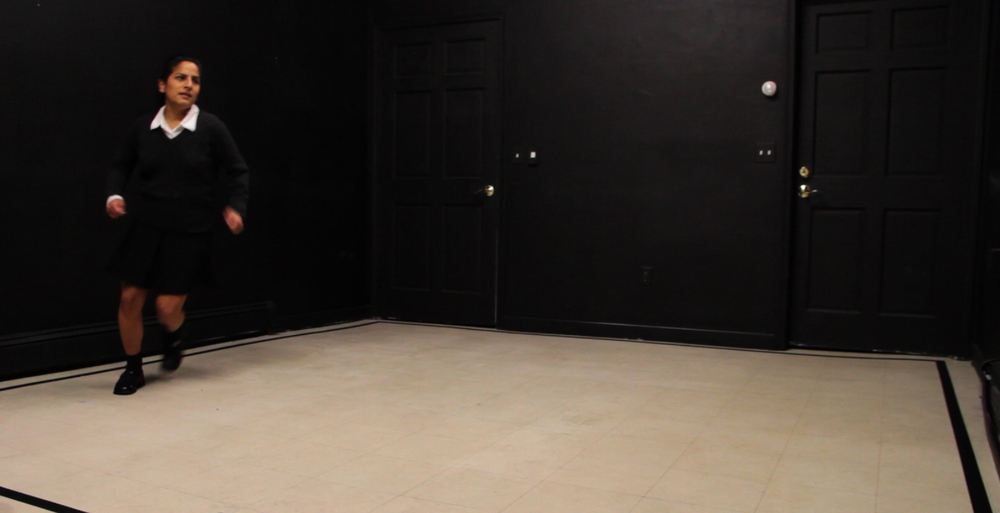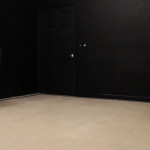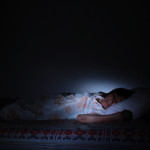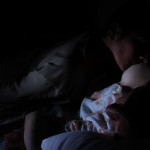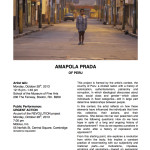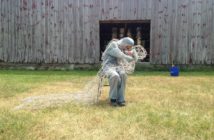I recently was in Perú again to visit my family and met up with Amapola to hang out and talk about this interview. After my return to Boston, we arranged a Skype date and spoke about pessimism, generations, migration, and family, as these are explored in two specific videos La Lucha and La Revolución from Amapola's series Modelo para Armar and also touching on the Revolution series as well.
Amapola Prada, La Lucha (Struggle). 2013
Ximena Izquierdo Ugaz You came to art through performance, and I was wondering what brought you to video?
Amapola Prada I prefer not to call it performance art, because that has specific connotations. Since I didn’t come from an art background, it feels like I just discovered that the body had a lot to offer. It was closer to an impulse that was stored in my body, one which felt like it didn’t have a space to present itself outside. My first actions were more visceral for that reason; I was being curious and I wanted to explore these instincts, but later I began thinking "who cares about changes that are happening inside me as an artist?" So even though it started with the body, I wanted to do something different with the series Modelo para Armar. I also felt that because my body has specific characteristics, the actions that I do with it relate to my self, which created a limitation if I was the only performer. I wanted to open this more, so I thought: what if I create a structure and put people inside it and see what happens? For example in La Lucha (The Stuggle) you don’t know who will win, but the premise for the performers was to put their biggest effort into winning the game. I had worked with video before, but those early videos were shot very simply and the action was performed for the camera. In this latest project, partly because I had the support of a Franklin Furnace grant, I was able to use more cameras, to ask some people to help me, and to work with others. I had this money and I wanted to do something new.
XIU I feel that both La Lucha and La Revolución are dealing deeply with generations. In La Lucha, the action of the musical chairs has the backdrop of one of the neighborhoods in the outskirts of Lima—what we would call los conos. When you were in Boston we spoke about your family migrating from the interior of Perú to Lima. Where did they come from? And what does it mean to map the migration of your own family in the national imagination of progress?
AP My grandma and grandpa, on my mother’s side, came from Ayacucho and Ancash and, on my father’s side, from Ancash and Abancay. This whole project focuses on themes of quotidian aggression, migration, and the city because I think I wanted to put some emphasis on things that were not frequently spoken about and yet say much who we are. We talk about Lima being a city where the migrant population is very large in very general terms, but most often we don’t identify ourselves as second or third generation migrants. To me this was always very interesting and I always had many questions about it. Many years ago, I studied Social Psychology with the idea of trying to understand this place. I have family in the conos and I was living in Breña, which at the time was a lower middle class neighborhood, now less so. You can see the progress of the city mainly in San Isidro, Miraflores, San Borja, or newer places like La Molina, but in older places, more traditional or more middle class neighborhoods, the progress is less noticeable. My grandmother from my father’s side lived in Comas, and my aunt lived in Canto Grande, and to get there I had to go through Plaza de Acho. You can imagine in the '80s and early '90s this place, and the center of Lima, were covered in trash and I always noticed quotidian things, the hostility of the people and the city—what was going on with us?
Nowadays, we have this alleged economic growth, and we are proud of our country, but when I was a child, we suffered through a great economic crisis under President Alan Garcia. I grew up in the '80s, in the context of Sendero Luminoso1. You knew that something was happening because of the constant blackouts, bombs, news about deaths and car-bombs. That sense of insecurity and the general aggressiveness of people, the streets full of trash which people weren't taking care of, made me wonder "where am I?" And I think I always wanted to try to do something about it, which is why I studied Social Psychology. The Social Psychology degree didn't help me understand it any better, so I started to ask my own questions, just looking at myself and where I was, all the while very aware of my physical aspect, of my roots, and what it meant to be in my body in this situation. And also I started to see other discourses that gave names to my questions about race or social class. This language was not something that I was taught when I was studying Social Psychology. We didn’t talk in those terms, maybe "racism" and "discrimination" but, related to Perú, never; we never had this conversation in any class. I didn’t know of any historical school of thought that dealt with these ideas.
XIU How did you find the language to start talking about these concerns?
AP The first moment was when I attended one of the Encuentros of the Hemispheric Institute of Performance and Politics that happens every two years and I saw that some people had a background of using words like "race", "class", "gender", etc. And from that I was able to make evident what was happening to me. I wanted some order, because you know so much is happening here: Lima is a big laboratory of the worst, sometimes the best, but in general the worst, from my point of view . . . from my pessimistic point of view.
XIU Do you feel like a lot of those feelings also arise from growing up in the generation that you did? From being a kid in the '80s in Perú?
AP Yes. I think youth of the current generation believe more in their country. I grew up at a totally pessimistic moment: we had nothing to be proud of, or it felt that way from my point of view. There was no money and there was no hope. And then maybe with Alberto Fujimori, people started to have a little more money, and today they are proud of the food and things like that, and Machu Picchu. [Laughs]
XIU And it is this narrative that I feel President Alejandro Toledo was really pushing too: "You can make it if you try."
AP Because Toledo was embodying the American Dream.
XIU How did you feel when you finally found the words to talk about the questions you had?
AP I think that when you can call things by their name they are more present; I mean they become present. For example, how do you discover that your relationship is abusive? Maybe you are not feeling so well because you are receiving some kind of aggression. And you start to ask yourself "What’s going on? I love this person but it's confusing." And then maybe you gain access to a dictionary which contains some behaviors that you can identify as abuse and relate to what is happening to you. And that gives you a kind of strength or a context to be able to talk about it.
XIU What does it mean to have your body in the public space of Lima, running with your parents in the street, for example, and how does that become part of public memory? I am connecting this to the way that public space is already used and negotiated in Lima by artists/non-artists, thinking about where this action fits in the imaginary of the street where there are always people doing seemingly irrational things. What is the boundary of those actions?
AP The precedent for this action was a piece, Direccion Norte, which I did alone on a different avenue. In the first action I was naked in the street and only the people who were working with me knew that I was doing this on this specific day. It was an action for myself in a chaotic place with many people in the street—some homeless or ostensibly crazy people all doing things, and no one cares what is happening. I remember that a policewoman on a motorcycle was there and she saw me and continued riding because the cameras were very far, and she probably thought that I was another crazy person on the street like many crazy naked people that are just walking. The run I did with my parents followed the same direction, North. Imagine that the people in the street start acting on what is on the inside. There is an order and pattern to the street: you can’t be naked, you can’t start dancing or singing in the middle of the street. But I like the idea of doing an action that comes from something internal and makes sense to you. You can live on those terms, because it comes from something related to your emotions or your subjectivity. If you are extremely happy, and if you are able to bring it out, it would change your actions or how you move from place to place. I like to work in this space of being in familiar spaces but doing something unfamiliar, something that doesn’t really fit, yet is happening and is related to the person performing the action.
XIU I know that your parents haven’t been together since you were a kid and I was thinking that, in a way, La Revolución works as a sort of family tree, but one which takes place in a very visibly frenzied space. The movement of the cars, the sound of the city create an archive of your family in that situation, as you are moving North or forward.
AP I think after Direccion Norte I started to concede that this action was an acceptance of what I am, what I like and what I hate. Some of this I related to the past, with the expectations, emotions, fears, frustrations that perhaps you can’t talk about, but that you need to process, ones that are not necessarily your own but are transmitted through generations. Then, our parents are our first contact with life, and what happens in our personal history is something, but my father and my mother also each have a history of their own. The work of resolving the previous generations is concentrated in my body. Through my parents, I connect with these generations, and with them I intend to traverse the conflict. When I move, they move; when they move, I move; when we ourselves move, we also move the preceding generations, and the next. But also this video has the name Revolution because for me the most difficult thing is to work deeply in the seemingly simple—in the end, it is not really that simple, because it has so much weight. Our bodies hold generations, especially in this country, because I think that we need a big change that is like a revolution. Historically, it is our aspiration. I think a first step is to find some kind of harmony, to run to the same place for a first time, even if it is a fiction. It’s about inventing a moment and being able to say, I once ran with my parents in the same direction, towards a North, which in itself is nothing, but now becomes something.
XIU And you have the evidence to prove it.
AP Yes. I am also saying that revolution is related to something on the most molecular level: I as an individual came (in the most basic way) from two, and from there comes more, but that's where it begins. And this is my idea of revolution I think. I’m aware of revolutions that happened but I don’t believe in them, because some other people were involved in them and those people have power. In the end, there is no coherence. In the end, the ideal is destroyed. But I ask "how do you do it?" Maybe it’s a whole life’s work, trying to reach that.
XIU What is the reception of both your work and your body in Perú and the States?
AP I think because I didn't attend an art school I feel like I don’t have a community. I’ve showed my work here in friends’ spaces but not in more established places, like galleries, and I didn’t look for it either. I didn’t knock on doors. Maybe it’s a prejudice of mine but I felt like they wouldn’t be open to showing my kind of work. Or maybe I don’t feel so close with what is being shown here. Once a curator that was putting together a video art show here said that my work is interesting but not video art. Around the same time a Cuban curator in San Francisco picked up my work as Latin American video art. I show my videos to someone who is related with a curatorial space and I don’t get an answer. But when I show this work outside Perú, people like it. Maybe I am not connected enough here. Or maybe it's that my body doesn’t call that much attention: in the street here I am invisible because everyone is like me. Perhaps if I were European, or new to the city, I would get more attention.
XIU Do you think it is the opposite in the States because you are in your body?
AP Yes, of course, I think this will always be present. I don’t know if it’s because of my body but I can say that my work is received differently. It’s real. I haven’t shown my work in the United States so many times: I just applied to open calls. In Perú there are not so many open calls. There are open calls in independent or alternative spaces.
XIU Do you feel that the art communities in Lima or the US want to have the conversations that you are trying to jolt about race, gender, class?
AP Yes, I think people are open to it. But I like to speak from my self. Some people start thinking about this by talking about others, by trying to defend poor people or ideas. In general, I like it when I see someone emotionally involved in what they are talking about. It's easier just to talk about ideas. I like work which shows some emotional involvement too, because it becomes more than just talking about ideas and democracy. I don’t often see much talk about artists who try to speak about big themes from their body or their lived experience.
XIU Do you think that has changed over time? That maybe in the '70s or '80s artists and thinkers in Perú were talking about these questions more and have gradually ceased due to a long history of cultural repression?
AP The '70s and '60s were present in my memory when I was a child: I knew that in the past there was a stronger sense of community. These ideas were closer to me than to someone who grew up in the '90s. Nowadays, I don’t think that that memory is as present. It may be for some people who are curious, or whose parents are socially involved or are academics, but it is possibly more abstract, especially because now everything is seemingly okay. The problem is that when people are get more comfortable economically they become less critical. The media covers any kind of upheaval in a biased way. So these feelings and ideals are not so much in the air, like they are forgotten. I don’t have a clear idea of what the new generations are like, but just seeing what's on TV I’m not so optimistic. I think that feeling proud of your country can also be a kind of control or comfort.
XIU In relationship to that, where do you see the situations in the Revolution series fitting in the present moment?
AP I don’t know if they fit. Each video has a name that relates to revolution as we perceived it before, for instance "unity," or uniting a mass of people around an idea. Because I am a pessimist I don’t think it’s possible. But the idealist in me believes that everyone has some work to do internally. I think our work is to be aware more than just talk about theories, to see ourselves in the present moment, and to acknowledge how we are repeating violences of the past and conflicts generation to generation. Everyone wants to have a better country, and a better life for everyone. Well, at the very least a better country, or perhaps not "country," but the place where you are. It's our tendency to criticize everything we actually have.
So this concept of Unit/y is pessimistic, but at the same time it becomes empowering because it reminds you that you only have yourself. Giving yourself a moment to wake up, and stand up, and be there, isn't quite the same as motivating action, but at the same time, there I am standing in this neighborhood acknowledging that these are its conditions. We are in a moment of "economic surge" but this place is worse than before, this is Breña. I don’t believe in what they are saying. What is this progress? This is where I am; this is my point of beginning. This is my way of accepting that I am not where I think I am, or at least not where they want me to think that I am. Let’s not inflate some ideas, or start from some invented ideas. This is who we are, this is a place that is familiar to me, and it is not the idea of Lima that they want to sell us. But to stand up in that place, I think, is the way, because I am not thinking that I am more than I am. It is difficult to start a revolution from that place. These are not realistic actions. It doesn’t mean anything if you stand still in the street, or suckle at your mom's tit, but it’s the same idea. In my video La Fuerza, my mother is old. What sustenance can I get from her breast? But it shows the intention of connecting to life: this person is alive and is also my mother. This is not totally empowering, but it’s about coming to terms with the conditions of where I start and I am.
XIU What is in your future?
AP I would like to write. And, this is difficult for me and I think I have expressed this interest before and it hasn’t happened yet, but I would like to speak. Use the words. Not necessarily in performance but to talk. By starting from the body, I wanted to discover something. I think about what these images and the body say before starting an artistic discourse or allowing for a process of discovery regarding what I want to say and finding my position. I would like to work more on that. I want to learn a lot more and maybe . . . yes, learn more.
Amapola Prada, La Revolución (Revolution), 2013
- Amapola Prada, Urgent Action 28 October 2013 Mobius, Boston
- Amapola Prada, Urgent Action 28 October 2013 Mobius, Boston
- Amapola Prada, La Fuerza, 2011
- Amapola Prada, La Fuerza, 2011
[1] Shining Path, a Peruvian Maoist revolutionary movement, founded in 1970 and led by Abimael Guzmán (1934—) until his capture and imprisonment in 1992. At first the movement operated in rural areas, but in the 1980s it began to launch terrorist attacks in Peruvian towns and cities.
Source: Wikipedia

